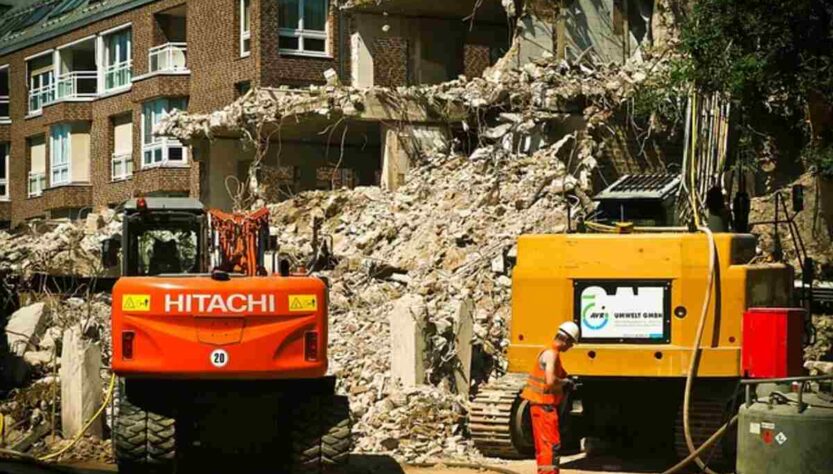Demolition of concrete structures is often an extensive and lengthy process. Hiring a professional contractor to handle this work efficiently may make your life much more straightforward. Best way to find the San Bernardino Demolition Contractor.
Most contractors charge between $2 and $6 per square foot for concrete removal, including labor costs and dumping fees. They may also charge per ton if an entire foundation or structure is demolished with lots of concrete.
Do-It-Yourself Guide
Cracked and crumbling concrete driveways, sidewalks, or slabs can quickly become trip hazards and eyesores on any property if left to decay. When this occurs, the best way to restore both its appearance and safety is to have it demolished and rebuilt with fresh concrete—something that requires special tools and should only be attempted with professional guidance and instruction.
The cost of concrete removal varies significantly by region. Contractors generally charge by the square foot, though some may include project minimum or disposal fees in their estimate. The size of the slab is another key factor affecting price, as are any necessary permits that might increase overall expenses.
Demolition contractors typically charge higher prices for projects in urban locations because they are harder to access and require more costly debris removal.
Saving money when it comes to concrete removal projects by purchasing all necessary equipment yourself can save money, but you must know what you are getting into first. Removing concrete can be hard work that can result in serious back injuries if done improperly, so be sure to purchase quality gloves and back support belts as protection while breaking up concrete with a sledgehammer or pry bar.
Do-It-Yourself Demolition Tools
While demolition may appear like an easy and enjoyable DIY project, it requires special equipment. Furthermore, safety gear such as eye goggles, masks, thick gloves, and boots is essential. In addition, you will need to either purchase or rent a heavy-duty truck and dumpster; otherwise, the costs could quickly add up! When undertaking multiple concrete removal projects simultaneously, the additional expenses can quickly accumulate.
Start saving costs by investing in top-of-the-line hand tools for the task at hand, such as pry bars and crowbars that specialize in disassembling objects, various hammers for different types of demolition tasks, and tin snips that make cutting thin materials such as metal siding or plastic components easier.
An essential tool when undertaking demolition enables you to remove nails and screws that become embedded in walls or floors during demolition. A set of pliers with nail-pulling capabilities like Crescent Code Red Nail Plier will allow you to quickly pull out nails without damaging their shanks, making removal much simpler – ideal for pulling staples used to hold wallpaper up, nails used in picture frames, as well as staples used to hold wallpaper down, staples holding wallpaper together or nails from picture frames, as well as staples used to have wallpaper together or pulling down old tile or tearing up old tiles; for large-scale demolition jobs consider purchasing an adjustable prong demo fork that connects directly to heavy machinery that has adjustable prongs that grasp debris with precision allowing precise grasp.
Hire a Demolition Contractor
Professional demolition contractors have the equipment necessary for concrete demolition at their fingertips. Based on your budget and timeline for completion of the job, they can select the appropriate method or combination of methods. In addition, they provide advice regarding other projects, like landscaping, that might need doing at the same time.
When choosing a demolition company, consider its level of experience and tenure in the business. Request references from past customers and take time to speak directly with them about their experiences with the company; listen closely for any dissatisfaction or satisfaction points from past customers—these small details could make a big, impactful impression on a demolition service provider.
As part of your due diligence, make sure the demolition contractor you select carries both insurance coverage and is legally permitted to operate as a demolition contractor. Without such authorization in place, any accidents that arise on-site could place them liable.
After the demolition is completed, you should ask where they intend to dispose of materials left behind. Be sure that any company follows local regulations and does not dump debris in any ecologically sensitive areas. Furthermore, get at least two estimates before hiring any demolition company; this allows you to compare their pricing and determine which option will provide the most cost-effective solution for your task.
Demolition Safety
Demolition can be an extremely hazardous job, so proper precautions must be taken. Failing to do so has led to tragedies like that of 2014, where six construction workers died after becoming trapped under an unstable building being demolished. A comprehensive safety plan must be developed in order to manage hazards and avoid accidents.
Plan components should include an engineering survey to ascertain the condition of floors and walls, as well as any possible unplanned collapse, temporary protective structures (TPS), utility relocation/disconnection, and environmental hazards management. Furthermore, sites should be secured, and emergency equipment should be readily available.
Workers should receive personal protective equipment (PPE), which should be tailored appropriately and regularly inspected. Employees should receive training on selecting, fitting, inspecting, maintaining, and selecting PPE for themselves – in addition to training them on identifying and avoiding demolition workplace hazards.
Demolition debris should be collected for recycling on-site. Rebar can be incorporated into new concrete mixes, while wood waste may be recycled into mulch, recycled into manufactured timber boards, or used as type 1 crushed aggregate for ground stabilization purposes. An accredited asbestos abatement contractor should handle any asbestos-containing materials due to potential inhalation risks posed by inhalation exposure – therefore, disposable coveralls and respirators should always be worn when entering demolition zones.
